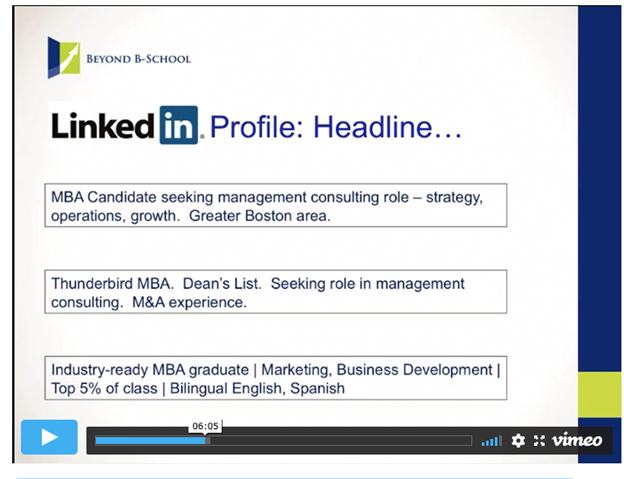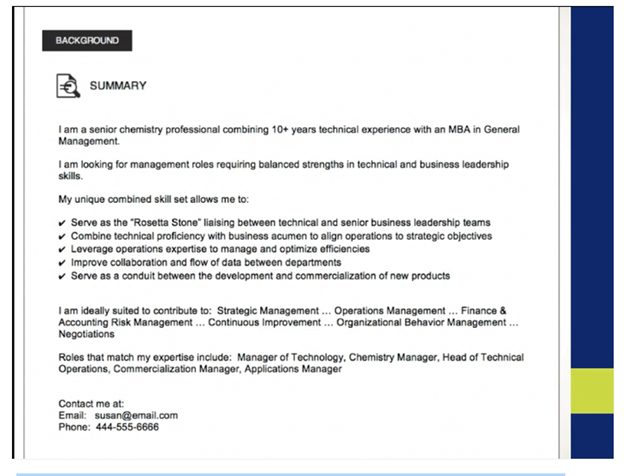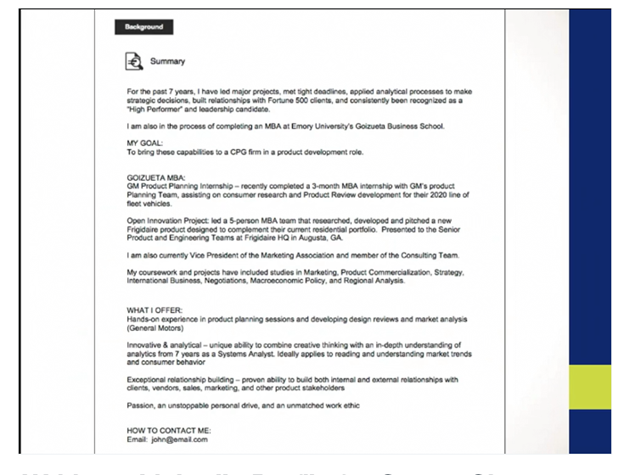
Writing a LinkedIn Profile for Career Change
with Ross Macpherson, President, Career Quest
Ross Macpherson states that the strategies used in creating your resume applies to your Linkedin but done differently. The following are the Do’s in creating your linked in profile:
- The information in your Linkedin profile should be about the New role and not focused on your current work.
- Your Headline which contains 120 characters should talk about your goals. It has to be concise.
- Make your case in the Summary. It should give your compelling reason for making the big switch
- Link any examples or proof of projects, accomplishments etc to your profile that would further strengthen your case.
HEADLINE : The headline speaks about your goals. It clarifies the move that you are making so it has to be strong and impactful. The illustration shows three different examples of headlines.
 SUMMARY:
SUMMARY: The same with building your resume, the summary should give a strong and impactful story of your big switch to the new role. It should catch the attention of the employer/recruiter. It should contain information about:
- What you CAN do in your new role.
- Information about your MBA and other related qualifications
- Relevant skills/accomplishments to the new role.
- Desirable attributes – this includes examples like dynamic, business oriented etc.
- Supporting information to prove your case of transitioning to the new role.
Here are Summary examples:
The first example talks about the moving from being technical to a management role. The Linkedin summary talks about the current role and education on the first line only. The succeeding lines talk about where the candidate wants to go; relatable skills to the new role; the use of the phrase “ideally suited to,” to highlight what the candidate can contribute to the employer; Since the candidate does not have any experience in doing the new role, positions that match his/her expertise were indicated.

The second example illustrates top-loading the Linkedin profile. It starts with providing a relevant and relatable experiences and a brief information about education. It categorizes important information related to the new role such as: what the goals are; applicable projects/skills; what the candidate can offer in terms of skills, experience and attributes.
 Other Tips:
Other Tips:
Other important things to remember when building a Linkedin profile includes :
- Transferring the information in your resume to your Linkedin profile by applying the methodolgies used.
- Include/add all relevant information from your Education such as skills, activities and projects etc.
- Re-ordering sections in your Linkedin profile is allowed as long as it is relevant and related to the new role.
- Employers/recruiters are looking at online groups you participate in. Include details about the online groups – groups for your new role.
Ross Macpherson reiterates the importance of building an impactful, relevant and concise Linkedin profile to be noticed as a strong candidate. Make a connection and make it easy for the recruiter/employers to connect the dots. Make a clear and compelling case for the switch. Let your output mirror who you are and show the how confident you are as a person for making the transition.
Ross Macpherson is the President of Career Quest, a Certified Personal Branding Strategist, Certified Online Identity Strategist, Certified Interview and Job Search Coach, and is recognized as one of the best resume writers in North America. With over 15 years experience in the career industry, he specializes in advanced strategies that help senior and executive professionals throughout the US, Canada, and internationally. His work has been featured in 18 career publications.
Ross routinely speaks to MBA programs across North America, and is known for delivering powerful and entertaining sessions that teach real-world success strategies. He has also spoken at major career events, global industry conferences, professional associations, and executive networking groups across the U.S. and Canada, and his high-energy style has consistently put him at the top of the career management speaking circuit. Contact Ross at [email protected]